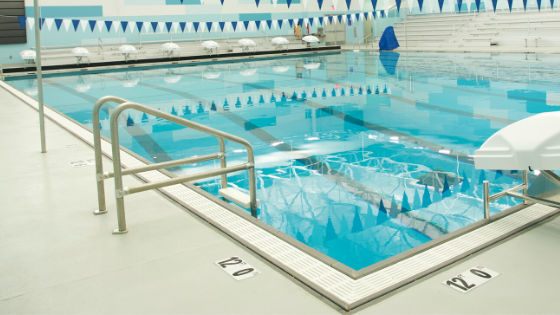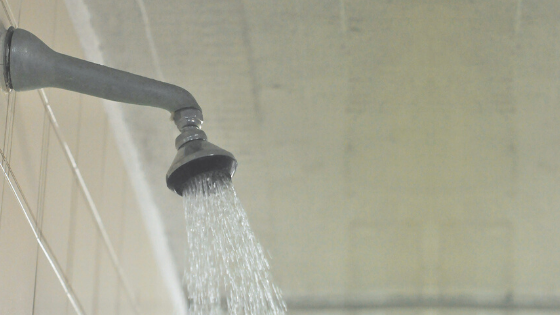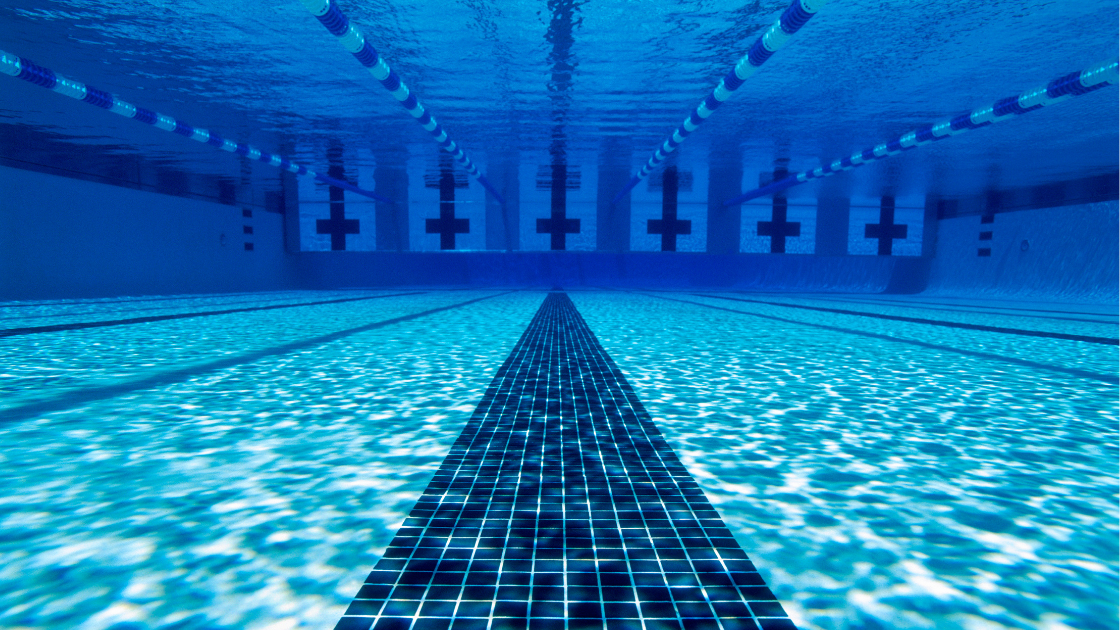What Makes a Swimming Pool Fast?
Fast swimming pools are considered "fast" when swimmers perform well in them. It's sort of an intangible amenity, but one that is well understood and respected by competitive swimmers. If a swimming pool has a reputation for being fast, it is a boost to the natatorium's income potential.
Pools have reputations
Let's start with a universal truth in the world of competitive swimming and diving: every competitive pool has a reputation. And that reputation can spread through word-of-mouth faster than you might think. While most people spread bad news faster than good news, swimmers are not always the same way. Swimmers are generally tough athletes who train hard and don't complain much. It is seen as a sign of weakness to complain about a pool, unless it is so bad that everyone is thinking the same thing. So even if a pool is sub-par, swimmers tend to keep their opinions to themselves.
But don't expect them to swim their best times either.
If the pool has bad indoor air quality, it can both physically and mentally slow swimmers down. Who wants to spend their weekend in an unhealthy, uncomfortable, humid natatorium? Swimmers certainly do not, and neither do the coaches, lifeguards, volunteers and parents who run the swim meets. They are there for hours on end too. Parents and coaches are more likely than swimmers to spread negative opinions of a pool that was a miserable experience for them. And who can blame them?
Either way, as a result, first impressions of a natatorium often occur before swimmers even visit the pool themselves. They have already heard about it through the grapevine.
Just because swimmers themselves rarely complain about pool conditions does not mean they are having a good experience at the pool. If swimmers dislike even being at the facility, you can bet they won't like racing there. And if they don't like racing there, they won't race fast. As you can imagine, unhappy swimmers do not help a pool build a good reputation for being a 'fast pool'. Happy swimmers do.
It pays to have a 'fast' reputation
A reputation of being a fast pool is one of the highest compliments a pool can have. It is also one of the most financially beneficial assets a pool can have. Swimmers want to be there. Their coaches want their swimmers to be there. And of course, swimmer parents want their kids racing there.
Everyone involved wants their swimmer(s) to swim the best times possible–whether it is to make a certain 'cut time' to qualify for a bigger meet, to get noticed by college recruiters, or to simply score points and do well. Fractions of a second matter in swimming. If a pool has a reputation for being fast, that pool is in demand, and word will spread in a good way.
While swimmers may be quiet about a mediocre or sub-par pool, they are usually quite vocal about a great pool. A great pool is inviting, and appeals to swimmers on an emotional level; a feeling of excitement to swim in such clean water. Swimming is a grueling sport, so getting to race in a beautiful venue is a reward.
Just seeing a great pool set up for a championship meet gets a swimmer's heart rate beating fast. You can expect fast swimming from them because happy, excited swimmers race better than unhappy ones. We will never forget the adrenaline rush from stepping on deck a few days before the US Olympic Trials in Omaha. The first time seeing that pool rendered most of the athletes and coaches speechless.

If you were a swimmer who trained for years just to qualify for a meet like Olympic Trials, this pool atmosphere is a well-deserved reward. There's nothing quite like that feeling.
Related: How big is an Olympic Swimming Pool?
'Fast' is subjective
Some people say that a fast pool takes "fast swimmers", but we disagree. It's not so much about really good swimmers showing up and racing. Hell, if that were the case, explain some of the dungeon-looking natatoriums and aging outdoor pools that many Olympic swimmers grow up training in. It's not a "fast pool" because Katie Ledecky shows up and beats everyone else (though she probably will, even if she's not swimming well).
Rather, a fast swimming pool is a place where swimmers–of all levels–swim well for themselves. We're talking about the average age-group swimmer who goes a best time, or a swimmer who finally pushes through a barrier after working so hard for it, and failing for months, if not years.
Fast pools are subjective to the swimmer, not to the scoreboard.
How to design a fast pool
Beyond the psychological aspects that invite swimmers to perform well (great lighting, sparkling clear water, fresh air quality), some key design features legitimately make a difference when it comes to how fast swimmers can move in the water. Let's cover some of them.
Depth

This 50m pool gets very deep but also goes as shallow as 4 feet. But at least the depth is consistent for all lanes, and when there is variance on the outside lanes (1 and 8), it's deep enough to not matter.
Most competitive swimmers agree that deep water is faster, but there is also a point where the water is "deep enough." The level where it becomes "deep enough" is subjective, and depends on the swimmer's size. Opinions vary, but our opinion is that anything deeper than that swimmer's height is deep enough. So a 9-year-old might be totally fine in 4.5-foot water, but the 6'3 collegiate male would find that very shallow for racing. The argument here is that turbulence will reverberate off the floor and come back to the swimmer. If the water is deep enough, however, no such rebounding turbulence will be noticeable.
What matters most, below the "deep enough" depth is the contour of the pool floor.
Even if only psychologically, having significant lane depth differences can be perceived as unfair. If lanes 1 and 2 are shallow, but lanes 6, 7, and 8 are deep, that can be seen as an unfair advantage to the deeper lanes. Depth and contour go together here, because whatever the depth changes are, the racing lanes should be equal–or at least, close to equal. A fair depth change would be everyone diving into the same depth, and all depth changes happen for all the lanes evenly. That way, nobody has any advantage–real or perceived.
Take breaststroke for example. Breaststrokers dive in deeper than most strokes because they have an underwater pull-out. A swimmer simply cannot go as far underwater in a shallow pool, because the trajectory off the dive must be at a less-favorable angle. This quells momentum and thus, shortens the pull-out. Breaststrokers hate shallow pools for this reason.
Ideal Depth
The ideal depth for racing is "deep enough" for the biggest swimmers that will be racing in the pool, and if depth changes do occur, they occur evenly for all lanes.
The international governing body for swimming, FINA, mandates that an Olympic Swimming Pool has a minimum of 2 meters in depth throughout, and any changes must be even for all lanes.
Water Quality Systems
Water clarity is critical to fast swimming. Nobody likes swimming in a cloudy, nasty pool. Fast pools have great filtration and a secondary disinfection system. Since swim meets often pack a lot of bodies into the water for warmup and warm-down, a fast pool needs systems in place to handle such a demand. To supplement chlorine, we recommend using enzymes, which will handle non-living organics that swimmers introduce to the water. Without these systems in place, water can get cloudy within hours. For multi-day swim meets, water quality is just as much of a struggle as air quality.
Ideal Water Quality Systems
In our opinion, top-of-the-line filtration would be Regenerative D.E., followed by a pressure sand filter using crushed glass media instead of sand. For outdoor pools, Ozone is the optimal secondary system because it is unaffected by sunscreen. For indoor pools, either UV or Ozone is great, though the edge goes to Ozone because of its ability to destroy precursors to chloramines. And finally, to address bather waste, aka non-living organics, NSF-50 Certified enzymes make a huge difference in the clarity and feel of water.
Gutters vs. Skimmers
There is no comparison between gutters and skimmers when it comes to a fast pool. Competitive pools should be gutter pools. Skimmer pools have too much turbulence and too little surface collection of nonliving organics and oils. Perimeter overflow gutters can keep the water at the same level, and virtually eliminate rebounding turbulence from the walls. Surface waves simply overflow into the gutter and do not bounce back.
This may be confusing for some because the FINA international standard requires a flat-wall touchpad, which actually creates more turbulence than an overflow gutter. American swimming–such as high school, USA Swimming, US Masters Swimming, and collegiate levels–often use "gutter-hung" touch pads that stay below the water, allowing for water to easily flow over them into the gutter or flow-through bulkhead. But internationally, the touchpad must cover up to the deck, so the swimmer has nothing to grab onto. See the photo comparison below.

Both styles have very fast swimming in them. Fast swimmers out-pace their wake, so getting to the wall is not an issue of turbulence. The name of the game is getting under the wake off a turn. This brings us back to depth as mentioned before. If the pool is too shallow, swimmers have a more difficult time getting under their own wake, and that slows them down.
Ideal Gutter and Touch Pads
The optimal gutter style is just one that is capable of handling all the waves (unlike a simple scum gutter, or shallow trough). We do not have an opinion one way or the other on using a flat wall or a gutter-hung touchpad, just as long as it's firmly attached to the wall and has a good grip. Nobody likes their hands or feet slipping during a turn.
For context of what we mean by "get under the wake", Michael Phelps was one of the greatest at it:
Tile and Markings
Even in a cloudy pool, most swimmers can clearly see the tile line at the bottom. If not, the pool is not safe to swim in regardless, because it would be too cloudy to see the main drain, which is a drowning hazard. This is not so much about whether or not a swimmer can see the tile on the bottom of the pool, but rather how well they can see the tile on the wall, or T marking on the bulkhead. When a swimmer is racing into a wall or bulkhead, the tile line on the bottom ends with a T, which is supposed to be a standard distance from the turn wall. For instance, the NCAA's pool dimension standards say five feet from the T to the wall.
Source: NCAA Swimming & Diving Regulations, pg. 13
But that distance is not always standard, because the international FINA standard is 2.0 meters from T to the pool wall. Two meters is just over 6'-6", so right there that's over a foot and half difference. But the distance between the T and the wall is really more of an issue from the swimmers perspective. Depth matters. A five foot distance looks very different when the pool is 4.5 feet deep compared to 12 feet deep. And if the pool wall and floor are strongly curved, like so many shotcrete pools are, the turn wall is deceptive and hard to gauge.
Ideal Tile and Markings
If a pool can be oriented in two directions (perpendicular to each other), tile lines can be confusing. Be sure the primary racing setup has the dominant tile lines, and the T is clearly marked. This can be confusing for bulkhead locations, but at least make them distinguishable from the cross-lines (see photo below in the Lighting section). The ideal here is for the wall tile to go down deep enough so that a swimmer does not have to pick up their head to see the wall. We recommend making the T on the wall at least 6 feet deep, or the depth of the pool if shallower than 6 feet.
Lighting

Yes, great lighting is mostly a psychological amenity that gets swimmers amped up to race. But underwater, lighting is also imperative for good visibility. If a pool has a lot of shadows or darker areas, it can be more difficult for swimmers to distinguish where the floor meets the wall, or where the bottom of the bulkhead begins. Much like tile and markings mentioned in the previous paragraph, bad lighting forces swimmers to lift their heads up to see where they are going. Lifting your head up slows you down, even if it's just fractions of a second.
Starting Blocks
Starting blocks need to be sturdy and easy to grip. Brand matters less than stability. We have seen top-brand starting blocks that are loose, and therefore bad. Starting blocks are only as good as the foundation they have in the ground (or bulkhead). A good block that is is not properly fastened in place will wiggle, and that makes a start unstable. Even if it moves just half an inch, that's half an inch of force being wasted for the swimmer. In a sport decided by fractions of a second, it matters.
A young, small swimmer may not move a block at all when they dive..but that same block could wiggle quite a bit for a 200+ pound swimmer in college (or older). Stability is the most important part of the starting block, hands down.
In 2010 or so, FINA adopted a 'wedge' that can be adjusted atop a starting block. All of the major starting block brands have their own adaptation of this wedge, which must conform within certain dimensions and angles. We can debate the merits and flaws of each type of starting block, but this article is about speed...it's about designing a fast pool. So start with a stable starting block, then think about ease of adjusting the wedge. Some are easier than others, which is important for the athletes.
Ideal Starting Blocks
Stability overrules all. If the biggest, strongest swimmers cannot move the block one millimeter, it's a sturdy block that will allow any swimmer to have a powerful start. Beyond that, just make sure it has decent grip so swimmers don't slip on the block itself. Fortunately, most starting block manufacturers already do well with anti-slip surfaces.
Lane Lines
In the United States, there are only a handful of lane line manufacturers that dominate the market. Lane lines separate swimming lanes (obviously), but they also serve another important role: quelling waves. The thinner the lane line, the less wave absorbing they can do. Some pools even double-up the lane lines for extra help. Simple lane ropes are not conducive to fast swimming, but well-designed lane lines are. Just be careful how they are handled and stored. Broken lane line parts don't work so well, as you can imagine.
Ideal Lane lines
Get lane lines that quell waves, but ALSO take storage into consideration. We see pools that have nice lane lines, but they get destroyed because of the elements. If lane lines have to be stored outside, be sure they are covered, and not susceptible to freezing temperatures over the winter. These temperature extremes can weaken plastic, which eventually means they break apart.
Conclusion
A competition pool with a fast reputation has more income potential than other pools. Swimmers will want to race there. When swimmers want to race there, they will be excited when they get to race there. That excitement brings adrenaline and better performance. Indeed, much of what makes a swimming pool fast is the psychological edge that invites swimmers to swim well. Everything about the environment matters; from great water clarity to lighting, and of course, indoor air quality (if the pool is indoors).
Then there are physical design considerations that go into building a fast pool. Depth should be "deep enough" for the biggest swimmers, and any depth changes should be consistent for all racing lanes. Starting blocks must be sturdy, lane lines must be able to quell waves, and the pool should have an overflow gutter system. Finally, tile lines on the floor AND wall should be easily visible so the swimmer can find the wall without having to pick up their head.
With all of these things in place, you can bet the pool is ripe for some fast swimming.

 By
By



